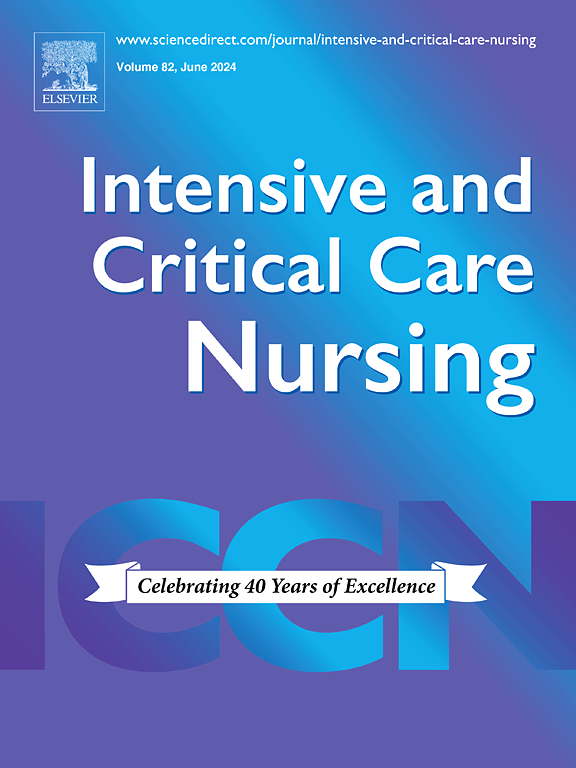Factors associated with significant post-traumatic-stress symptoms among bereaved family members of patients who died in intensive care units
IF 4.9
2区 医学
Q1 NURSING
引用次数: 0
Abstract
Objective
Few studies comprehensively investigate factors associated with significant post-traumatic-stress-disorder (PTSD) symptoms among family members of ICU decedents. We aimed to identify factors associated with significant PTSD symptoms among bereaved ICU family members, focusing on those modifiable through high-quality end-of-life ICU care.
Methods
A cohort study of 321 bereaved family members of critically ill patients assessed PTSD symptoms at 1, 3, 6, 13, 18, and 24 months postloss using the Impact of Event Scale-Revised (IES-R). Family-rated quality of dying and death (QODD) and ICU care satisfaction were assessed 1 month postloss using the ICU-QODD and Family Satisfaction in the ICU (FS-ICU) scales, respectively. Multivariable logistic regression with generalized estimating equations examined associations between significant PTSD symptoms and intrapersonal (demographics, vulnerabilities), interpersonal (perceived social support measured by the Medical Outcome Study Social Support Survey), bereavement-related (patient demographics, clinical characteristics), and death-circumstance (ICU-QODD and FS-ICU scores) factors identified from significant univariate analyses.
Results
Prevalence of significant PTSD symptoms decreased substantially over time (from 11.0 % at 1 month to 0 % at 24 months post loss). Financial insufficiency (adjusted odds ratio [AOR][95 % CI] = 3.281[1.306, 8.244]) and use of antidepressants in the year prior to the patient’s critical illness (AOR[95 % CI] = 6.406 [1.868, 21.967]) increased the likelihood of significant PTSD symptoms. Stronger family-perceived social support (AOR[95 % CI] = 0.964 [0.941, 0.988]) and higher family-judged patient QODD in ICUs (AOR[95 % CI] = 0.632 [0.435, 0.918]) lowered the odds of significant PTSD symptoms.
Conclusions
Modifiable end-of-life ICU care factors, i.e. higher family-judged patient QODD and family-perceived social support, reduced bereaved ICU family members’ likelihood of significant PTSD symptoms.
Implications for clinical practice
To reduce the likelihood of significant PTSD symptoms in bereaved family members, ICU clinicians should provide high-quality end-of-life care to improve patient QODD and leverage social support, particularly for at-risk groups with financial challenges or prior antidepressant use.
在重症监护病房死亡的患者的家属中与显著创伤后应激症状相关的因素
目的很少有研究全面调查ICU患者家属创伤后应激障碍(PTSD)症状的相关因素。我们的目的是在ICU丧亡的家庭成员中确定与显著PTSD症状相关的因素,重点关注那些通过高质量的临终ICU护理可以改变的因素。方法采用事件影响量表(IES-R)对321例危重患者家属在失联后1、3、6、13、18和24个月进行PTSD症状评估的队列研究。死亡后1个月分别采用ICU-QODD和ICU家庭满意度(FS-ICU)量表评估家属评定的死亡和死亡质量(QODD)和ICU护理满意度。使用广义估计方程的多变量logistic回归检验了显著PTSD症状与从显著单变量分析中确定的个人(人口统计学,脆弱性)、人际(通过医学结果研究社会支持调查测量的感知社会支持)、丧亲相关(患者人口统计学,临床特征)和死亡环境(ICU-QODD和FS-ICU评分)因素之间的关联。结果随着时间的推移,显著PTSD症状的患病率显著下降(从1个月时的11.0%下降到24个月时的0%)。经济不足(调整优势比[AOR][95% CI] = 3.281[1.306, 8.244])和患者危重症前一年使用抗抑郁药物(AOR[95% CI] = 6.406[1.868, 21.967])增加了显著PTSD症状的可能性。较强的家庭感知社会支持(AOR[95% CI] = 0.964[0.941, 0.988])和较高的家庭判断icu患者QODD (AOR[95% CI] = 0.632[0.435, 0.918])降低了显著PTSD症状的发生率。结论可检测的临终ICU护理因素,即较高的家属判断患者QODD和家庭感知的社会支持,可降低丧亲ICU家庭成员出现显著PTSD症状的可能性。对临床实践的启示:为了减少丧失亲人的家庭成员出现显著PTSD症状的可能性,ICU临床医生应提供高质量的临终关怀,以改善患者的QODD,并利用社会支持,特别是对有经济困难或既往使用抗抑郁药的高危群体。
本文章由计算机程序翻译,如有差异,请以英文原文为准。
求助全文
约1分钟内获得全文
求助全文
来源期刊

Intensive and Critical Care Nursing
NURSING-
CiteScore
6.30
自引率
15.10%
发文量
144
审稿时长
57 days
期刊介绍:
The aims of Intensive and Critical Care Nursing are to promote excellence of care of critically ill patients by specialist nurses and their professional colleagues; to provide an international and interdisciplinary forum for the publication, dissemination and exchange of research findings, experience and ideas; to develop and enhance the knowledge, skills, attitudes and creative thinking essential to good critical care nursing practice. The journal publishes reviews, updates and feature articles in addition to original papers and significant preliminary communications. Articles may deal with any part of practice including relevant clinical, research, educational, psychological and technological aspects.
 求助内容:
求助内容: 应助结果提醒方式:
应助结果提醒方式:


